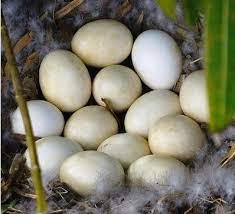
Meat Birds and great brooders(not technically a duck, they are their own species, but they are quite duck-like in appearance and taste) are a great choice for meat, being much leaner than true ducks and getting quite large (adult males weigh as much as 15 pounds). Select a white feathered strain for a clean-looking dressed bird. Muscovy females can hatch out a couple of huge broods of ducklings every year (a friend says her birds frequently hide nests and reappear weeks later with as many as 20 yellow fuzzballs in tow), so they are very sustainable. The downside is that young Muscovies fly early and well, and females continue to fly as adults (males eventually get too heavy), so catching your dinner can be a challenge. If meat is the plan, pen them as ducklings and butcher them as adolescents, before they get airborne. Duck meat is also delicious, and, if your ducks get plenty of exercise and a good diet, they won’t be as fatty as some commercial duck meat is. For a while, we raised Muscovy ducks and the meat was very similar to a beef roast
Indian Runner
Great egg layers These ducks look like little bowling pins running around. As they stand more upright than most duck breeds. Runner ducks have been around for thousands of years, according to Javan temple carvings that indicate this style of duck existed then.
Runners are great layers, laying 250 or more eggs a year, but aren’t very heavy making them great for eggs, not so much for meat. They’re a docile breed, but they are active. They love to explore and are great at foraging for bugs.
The khaki Campbell was the result of a cross between an Indian runner and a Rouen duck and resulted in one of the most prolific laying breeds there is amongst ducks.

Khaki Campbell
Great Egg layers. A docile, beautiful duck you can expect khaki Campbells to lay anywhere between 250 and 350 eggs per year. Yes, almost an egg a day can be expected from this breed. We currently have one in our mixed flock and she has laid all year.

Your ducks can roam free or you can put them to bed at night in a warm dry shed or house. They can swim in something as easy as a kiddie pool and as fun as a rock lined water area with a sand bar you make yourself! It’s all up to you.
